
CO Alarm is a life-safety device that alarms when dangerous levels of
carbon monoxide are detected.
Features
• UL2034 and CSA 6.19-01 listed
• Detects carbon monoxide
• 5 year warranty
Learn about the dangers of carbon monoxide
and proper use of the CO Alarm by rst
reading sections 1 through 10.
Enroll by rst placing the panel into wireless enrollment mode. To send
the enrollment signal, press and hold the test button for several seconds.
Note, when enrolling into a Honeywell® panel (RE215), the test button
must be held for at least 10 seconds before the enrollment signal is sent.
General Enrollment Tips:
• The CO Alarm is not powered until the battery tabs are removed and it is
installed on the mounting plate. If the test button is not working, check to
ensure the CO Alarm is properly installed in the mounting plate.
• Use your hand or a cloth to muffle the sounder beeps when using the test
button for enrollment.
• The test button must be held for a couple seconds after the CO Alarm
beeps before it will send the enrollment signal.
RE115 Interlogix® Compatible Programming
• Recommended Sensor Group: 34
RE215 Honeywell ® Compatible Programming
• Zone Type: Carbon Monoxide
• Loop Number: 1
• The automatic enrollment signal (triggered by holding the test button for
at least 10 seconds) is only available 60 minutes after the device is first
powered up. If the enrollment is not working, remove the batteries for at
least 30 seconds, then re-install the batteries and try again.
RE215T 2GIG® Compatible Programming
• RF Sensor Type: Carbon Monoxide Alarm
• RF Equipment Code: [0860]
• RF Sensor Loop Number: 1
RE315 DSC® Compatible Programming
• Recommended Sensor Group: 81
Test the sensor by placing the panel into test mode and then holding the
test button for several seconds. Use your panel’s installation guide to
verify proper system setup.
Choose a location for the Alarm to be installed after reviewing section 3.
After choosing a location, refer to section 4 for details on installation.
ATTENTION! This manual should be read prior to use and retained for
further information.
I
N
S
T
A
L
L
G
U
I
D
E
I
CO Alarm

2. Carbon Monoxide - The Silent Killer
2.1 What is Carbon Monoxide?
Carbon monoxide (CO) is an invisible, odorless, tasteless, and extremely toxic
gas. CO is absorbed by red blood cells in the lungs, in preference to oxygen,
resulting in rapid damage to the heart and brain from oxygen starvation. CO
poisoning can cause death or severe ill health.
High levels of CO in a home can be caused by:
• Incorrectly or poorly installed fuel-burning appliances
• Blocked or cracked chimneys/flues
• Blocked vents or draft-proofing which makes areas with fuel-burning
appliances or fireplaces airtight
• Engines of cars, lawnmowers, etc. left running in confined spaces
• Portable paraffin or gas heaters in badly ventilated rooms
2.2 Symptoms of CO Poisoning
Many cases of CO poisoning indicate that while victims are aware they are not
well, they become so disoriented they are unable to save themselves by either
exiting the building or calling for assistance.
• Mild Exposure: Headache, running nose, sore eyes, “flu like symptoms”
• Medium Exposure: Dizziness, drowsiness, vomiting
• Extreme Exposure: Unconsciousness, brain damage, death
CO (PPM) Symptoms
35 The maximum allowable concentration exposure in any 8 hour period according to
OSHA
150 Slight headache after 1.5 hours
200 Slight headache, fatigue, dizziness, nausea after 2-3 hours
400
Frontal headaches within 1-2 hours, life threatening after 3 hours, also maximum
parts per million in ue gas (on an air free basis) according to US Environmental
Protection Agency.
800 Dizziness, nausea and convulsions within 45 minutes. Unconsciousness within 2
hours. Death within 2-3 hours.
1600 Headache, dizziness, and nausea within 20 minutes. Death within 1 hour.
3200 Headache, dizziness and nausea within 5-10 minutes. Death within 25-30 minutes.
6400 Headache, dizziness and nausea within 1-2 minutes. Death within 10-15 minutes.
12800 Death within 1-3 minutes
1. Read This First
• Replace the CO Alarm after approximately 10 years operation (see ‘replace by’
date on label).
• Do not install until all building work is completed to avoid contamination.
• This CO Alarm is intended for use in ordinary indoor locations of family units.
It is not designed to measure compliance with OSHA commercial or industrial
standards.
• This CO Alarm should not be used as a substitute for proper installation, use and
maintenance of fuel-burning appliances, including appropriate ventilation and
exhaust systems.
• This CO Alarm is not limited in use in typical single level and multilevel dwelling
units or apartment buildings where adjacent apartments may have similar systems,
as each unit has a unique ID.
• This CO Alarm is designed to protect individuals from the acute effects of carbon
monoxide exposure. It will not fully safeguard individuals with specific medical
conditions. Individuals with medical problems may consider warning devices
which provide audible and visual signals for carbon monoxide concentrations
below 30 ppm. If in doubt, consult a medical practitioner.

3. Where to Place CO Alarms
Per NFPA 720, Carbon Monoxide Alarms shall be installed as follows:
1. Outside of each separate dwelling unit sleeping area in the immediate
vicinity of the bedroom.
2. On every occupiable level of a dwelling unit, including basements but
excluding attics and crawl spaces.
3. Other locations where required by applicable laws, codes or standards.
The equipment should be installed using wiring methods in accordance
with the National Fire Protection Association’s Standard 72, 720. (National
Fire Protection Association, Batterymarch Park, Quincy, MA 02269)
IMPORTANT! Specific requirements for CO Alarm installation vary from state
to state and from region to region. Check with your local Fire Department for
current requirements in your area.
3.1 Ideal Carbon Monoxide Alarm Locations
• Every room containing a fuel burning appliance
• Rooms where occupants spend a considerable amount of time
• Every Bedroom
If the number of carbon monoxide Alarms to be fitted is limited, the following
locations should be considered when deciding where best to fit the Alarms:
• Any room with an appliance where people sleep
• Any room containing a flueless or open-flued appliance
• Any room where the occupant(s) spend most of their time
• In a single room dwelling, the CO Alarm should be placed as far away from
the cooking appliance as possible, but near to where the person sleeps
• If the appliance is in a room not normally used, such as a boiler room, the
CO Alarm should be placed just outside the room so that the alarm will be
heard more easily
3.2 Locating in Rooms WITH a Fuel Burning Appliance
• If there is a partition in the
room, the CO Alarm should be
located on the same side of the
partition as the potential source.
• If it is mounted on a wall, it
should be located at a height
greater than the height of any
door or window but still be at
least 6 inches from the ceiling.
• In rooms with sloped ceilings,
the CO Alarm should be located
at the high side of the room at
least 12 inches from the peak.
• The CO Alarm should be installed 5 to
10 feet horizontally from the potential
CO source.
• If it is mounted on the ceiling it
should be at least 12 inches from any
wall or light fitting.
12” (300mm)
Minimum
12” (300mm)
Minimum
300mm
CO Alarm
12”
(300 mm)

3.3 Locating in Rooms WITHOUT a Fuel Burning Appliance
Mount the CO Alarm relatively close to the breathing zone of the occupants.
Whatever position is chosen make sure it is possible to view the three LED
indicators.
CO Alarm
about
1 to 2m
3 - 6.5 ft
(1 - 2 m)
3.4 Where Carbon Monoxide Alarms SHOULD NOT be Located
• Within 3 feet of a cooking appliance
• In an enclosed space (e.g. in or below a cupboard)
• In a damp or humid area
• Directly above a sink or kitchen appliance
• Next to a door, window, air vent or anywhere that it would be affected by drafts
• Next to an extractor fan
• Over heat sources such as radiators or hot air vents
• Where it would be obstructed (e.g. by curtains or furniture)
• In an area where the temperature could drop below 40°F (4.4°C) or rise above
100°F (37.8°C)
• Where dirt or dust could block the sensor
• In areas where the CO Alarm may be exposed to water splashes, dripping or
condensation (e.g. in a bathroom, above an electric kettle, etc.)
• Near paint, thinners, solvent fumes or air fresheners
4. Installation
4.1 Installation Procedure
1. Select a location complying with the advice in Section 3.
2. Remove the mounting plate from the packaging/Alarm.
3. Place the mounting plate on the ceiling/wall exactly where you want to mount
the Alarm. With a pencil, mark the location of the two screw holes.
4. Taking care to avoid any electrical wiring in the ceiling, drill holes using a
13/64” (5.0mm) drill bit through the center of the marked locations. Push the
plastic screw anchors provided into the drilled holes. Screw the mounting
plate to the ceiling/wall. Alternatively, if desired, the CO Alarm can also sit on
a flat surface with mounting plate attached.
5. Ensure the RF module is fitted correctly into the base of the Alarm.
6. Remove the battery door, gently pull the battery tab, and replace the battery
door.
7. Carefully line up the Alarm on the base, gently
press home & twist on (this connects the
batteries). The red, amber & green LEDs will
immediately flash in sequence to show they are
working.
8. After waiting at least 15 seconds, press the test
button to ensure the alarm is working properly.

4.2 How to Tamper Proof the CO Alarm
To make the Alarm resistant to unauthorized removal, break off the small pillar on
the battery door of the base as shown in the figure below. To remove the Alarm
from the base use a small screwdriver to release the catch by pushing it upwards
and then twist off the Alarm. If necessary it is possible to further secure the CO
Alarm by using a No. 2 or No. 4 self tapping screw 6 to 8mm long to firmly lock
the Alarm and its mounting plate together.
5. Testing and Maintenance
5.1 Testing
Frequent testing of the system is a requirement to ensure its continued and safe
operation. To test the Alarm press and hold the test button for several seconds.
The green LED will flash and the horn will ramp up to full sound to indicate the
Alarm is operating correctly. The unit should be tested as follows:
• After the system is installed
• Once weekly thereafter
• After prolonged absence from the dwelling (e.g. after a holiday period)
• After repair or servicing of any of the systems elements or household
electrical works
5.2 Maintenance
Clean the outside case by occasionally wiping with a clean damp cloth. Do not
use any cleaning agents, bleaches, detergents or polishes, including those in
aerosol cans. Avoid spraying air fresheners, hair spray, paint or other aerosols
near the CO Alarm. Do not place air fresheners near the unit. Use the narrow
nozzle of a vacuum cleaner to remove fluff and other contamination from the
cover slots and gas entry holes. Remove the CO Alarm when decorating. Do not
allow water or dust to contaminate the Alarm.
WARNING!
• Do not paint the CO Alarm
• Do not open or tamper with the CO Alarm. There are no user serviceable
parts inside and this can damage the Alarm.
5.3 Battery Replacement
• Check the Replace By label on the side wall. If it has been exceeded, replace
the entire unit. If the Replace By label on the side wall has not been exceeded,
remove the Alarm from the mounting plate, remove the battery cover, and
remove the old batteries.
• Use only Duracell® Alkaline MN2400BK AAA size
batteries (available from local retailers). Use of
a different battery may have detrimental effects
on alarm operation. Insert the new batteries and
replace the battery cover. Reinstall the Alarm back
on its mounting plate. Button test the Alarm (after
15 seconds) to check the batteries are installed
correctly and that they are not depleted.
WARNING! Constant exposures to high or low temperatures or high
humidity may reduce battery life.

6. CO Alarm Behavior
6.1 Pre-Alarm (before horn sounds)
When the Alarm detects CO concentrations over 50 ppm, the red LED flashes
in accordance with section 6.2. This helps locate CO leaks as the unit gives an
indication straight away. Without this feature the CO level would need to be at
50 ppm CO for typically 90 minutes for an alarm sound to be given.
NOTE: The pre-alarm signal may be triggered by CO coming for example,
from cooking with gas, from car engines, or from nearby barbecues. This
is usually not a concern, unless the pre-alarm signal persists until the alarm
sounds and the CO source is unknown.
NOTE: The CO Alarm may sound if cigarette smoke is blown into it, or
aerosols are released nearby.
6.2 Alarm Response Time and Indicators
The table below shows how the CO Alarm reacts to different CO gas levels and
exposure time. At higher CO levels, the alarm turns on sooner. The rate at which
the red LED flashes indicates the level of CO. If your CO Alarm sounds, follow
the instructions in Section 7. NEVER IGNORE THE ALARM!
CO Level Red LED Sounder
0 - 30 ppm Off (1) Off
> 50 ppm 1 flash every 3 seconds On within 60-240 minutes
> 110 ppm 2 flashes every 3 seconds On within 10-50 minutes
> 250 ppm 3 flashes every 3 seconds On within 4-15 minutes
(1) Unless it has alarmed previously (see Section 6.3 Alarm Memory)
6.3 Alarm Memory
The CO Alarm memory is an important feature of the CO Alarm where even if
the house is unoccupied during an alarm condition it warns the homeowner that
the CO Alarm has previously detected CO gas and been in alarm. The memory
feature has two operation modes:
• 24 Hour Memory Indicators: For 24 hours after an alarm, the red LED will
flash at different rates every 50 seconds depending on the level of CO
detected.
• Memory recall on demand: To review the memory status after the initial 24
hours, press and hold the test button. The red LED will flash at different rates
depending on the level of CO detected.
CO Level Alarm Memory - Red LED Response
24 Hour Memory Memory Recall (button press)
> 50 ppm 1 flash every minute 1 flash
> 110 ppm 2 flashes every minute 2 flashes
> 250 ppm 4 flashes every minute 4 flashes
To reset the alarm memory, hold down the test button until the red LED stops
and the green LED starts flashing. Cover the horn with a cloth to muffle the
alarm during this time. Please note that the CO Alarm memory will also be reset
when the CO Alarm is powered off.
6.4 Silencing the CO Alarm (Hush)
When the Alarm sounds after sensing CO, pressing the test/hush button will
immediately stop the horn (the red LED will continue to flash). If CO is still
present, the red LED and the horn will turn on again after about 4 minutes. The
unit can only be silenced once during a CO incident. At CO levels greater than
300 ppm, the unit cannot be silenced!

7. What to Do When the Alarm Sounds
WARNING! Actuation of your Alarm indicates the presence of carbon monoxide
(CO) which can KILL YOU. NEVER IGNORE THE ALARM!
1. Push the Test/Hush button.
2. Immediately evacuate the premises leaving the doors and windows open. Do a
head count to check that all persons are accounted for.
3. Call your emergency services Fire Department or 911.
4. DO NOT re-enter the premises until the emergency services responders have
arrived, the premises has been aired out and your Alarm remains in its normal
condition.
5. After following steps 1-4, if your Alarm reactivates within a 24 hour period,
repeat steps 1-4 and call a qualified appliance technician to investigate for
sources of CO from fuel burning equipment and appliances, and inspect for
proper operation of this equipment. If problems are identified during this
inspection have the equipment serviced immediately. Note any combustion
equipment not inspected by the technician and consult the manufacturers’
instructions, or contact the manufacturer directly, for more information about
CO safety and this equipment. Make sure that motor vehicles are not, and
have not been, operating in an attached garage or adjacent to the residence.
NOTE: When ventilation is provided by leaving the window and doors open, the
CO build up may have dissipated by the time help arrives and the Alarm may have
stopped sounding. Although your problem may appear temporarily solved, it is
crucial that the source of the CO is determined and appropriate repairs made.
8. Troubleshooting
8.1 Alarm does not work with the test button
• Check the Alarm is secured correctly on the mounting plate
• Wait 15 seconds after connecting the power before button testing
• Hold button down firmly for at least 5 seconds
• Replace the batteries
8.2 Alarm sounds for no apparent reason
Follow the instructions in section 6. If there are still problems:
• Ensure there are no fuel burning appliances in the vicinity which could be
leaking CO gas (e.g. even from next door)
• Ensure there are no fumes in the area (e.g. Paint, thinners, hair spray, chemical
cleaners, aerosol sprays, etc.)
• Ensure there is no outdoor source of CO in the vicinity such as a running
engine, heavy traffic, or heavy air pollution
• Ensure there is no source of hydrogen such as batteries being charged
• Ensure there is not excessive smoke or fumes from smoking devices
• Press the test/hush button to silence the alarm
8.3 Trouble Conditions
The CO Alarm will monitor itself and give a status update every 50 seconds if
there are any problems. The status of the Alarm can also be checked on demand
by using the test button. The CO Alarm will beep and the amber LED will flash
to indicate a fault condition as follows.
CO Alarm Fault Table
Fault Condition Fault Indication Action
Low Battery 1 beep with 1 amber flash Replace batteries (see §5.3)
Faulty Sensor 2 beeps with 2 amber flashes Replace Alarm
End of Life 3 beeps with 3 amber flashes Replace Alarm
NOTE: If the CO Alarm has detected a fault, pressing the test/hush button
will silence the beeps for a 24 hour period. This is for your convenience and
can only be done once.

(1) If a faulty sensor is detected, or it has reached the end of its service life, the CO
Alarm will also stop sending supervision transmissions.
IC NOTICE
This device complies with Industry Canada license-
exempt RSS standard(s). Operation is subject to the
following two conditions:
(1) This device may not cause interference, and
(2) This device must accept any interference, including
interference that may cause undesired operation of
the device.
Le présent appareil est conforme aux cnr d’Industrie
Canada applicables aux appareils radio exempts de
licence. L’exploitation est autorisée aux deux conditions
suivantes:
(1) L’appareil ne doit pas produire de brouillage, et
(2) L’utilisateur de l’appareil doit accepter tout
brouillage radioélectrique subi, même si le
brouillage est susceptible d’en compromettre le
fonctionnement.
IC: 8310A-RE115, 8310A-RE215, 8310A-RE315
WARRANTY
Alula will replace non-portable products that are
defective in their rst ve (5) years and all defective
portable products in their rst two (2) years.
FCC NOTICE
This device complies with Part 15 of the FCC rules.
Operation is subject to the following two conditions:
(1) This device may not cause harmful interference.
(2) This device must accept any interference that may
be received, including interference that may cause
undesired operation.
Changes or modications not expressly approved by
Alula could void the user’s authority to operate this
equipment.
FCC ID: U5X-RE115, U5X-RE215, U5X-RE315
TRADEMARKS
Alula and Connect+ are trademarks owned by Alula
Holdings, LLC. INTERLOGIX, HONEYWELL, DSC,
AND 2GIG ARE TRADEMARKS OWNED by United
Technologies Electronic Controls Inc., Honeywell
International INC., Tyco Safety Products Canada LTD.,
and Nortek Security & Control LLC, respectively. Alula
products will function with one of either interlogix
(formerly GE), Honeywell, DSC, or 2GIG systems.
However, no Alula Product is produced by, endorsed
by, nor is ofcially associated with INTERLOGIX
(formerly GE), HONEYWELL, DSC or 2GIG. Alula
recommends verifying proper enrollment and
operation, per control panel installation instructions, at
installation.
10. Specifications
Housing Dimensions
Weight with Batteries
Mounting Fastener
4.7 x 4.1 x 1.6 inches (12.0 x 10.4 x 4.1 cm)
6.53 ounces (185 grams)
#6 screws and anchors (provided)
Operating Temperature
Maximum Humidity
32°F to 104°F (0°C to 40°C)
15% to 95% non-condensing relative humidity
Replacement Batteries 2 x Alkaline AAA Batteries (Duracell MN2400BK)
Sensor Indications Low Battery, Supervision, Removal Tamper, Fault, End of Life
Audible Alarm 85 dBA at 10 feet (3m) minimum
Compatible Panels
Simon XTi 600-1054-95R-12 (RE115), Honeywell Lynx Touch L5200
(RE215), 2GIG-GC3-345 (RE215T), DSC PC1832 (RE315), Connect+
RE6100 (RE615)
Frequencies
319.50 MHz (RE115)
345.00 MHz (RE215/215T)
433.92 MHz (RE315/RE615)
Certications/Listings FCC, IC, UL2034, CSA 6.19-01
Specications subject to change without notice
9. Panel Response Details
Condition Panel Response to Condition
Interlogix Honeywell 2GIG DSC Alula Connect+TM
Test Button Alarm Alarm Alarm Alarm
CO Test
Indication (single
Temporal 4 siren)
CO Alarm Alarm Alarm Alarm Alarm Alarm
Removed
From Base
(Tamper)
Tamper Tamper Tamper Tamper Tamper
Low Battery Low Battery Low Battery Low Battery Low Battery Low Battery
Fault(1) Tamper Fault Tamper Fault Fault
End of Life(1) Tamper Fault Tamper Fault Fault
https://alula.net/knowledge-base/
co-info/
Additional Information 47-0024-00 • REV A • 2018-02-27
Tech Support Line • (888) 88-ALULA • (888) 882-5852
alula.net
00
-
 1
1
-
 2
2
-
 3
3
-
 4
4
-
 5
5
-
 6
6
-
 7
7
-
 8
8
Alula RE215 Owner's manual
- Category
- Carbon monoxide (CO) detectors
- Type
- Owner's manual
Ask a question and I''ll find the answer in the document
Finding information in a document is now easier with AI
Related papers
Other documents
-
Honeywell 5800COA Installation And Setup Manual
-
Kidde 8393852 Owner's manual
-
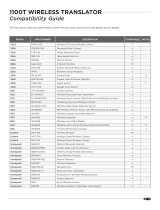 Digital Monitoring Products LT 2430 Compatibility Guide
Digital Monitoring Products LT 2430 Compatibility Guide
-
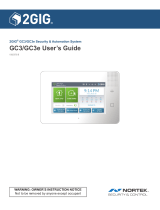 2gig GC3 User guide
2gig GC3 User guide
-
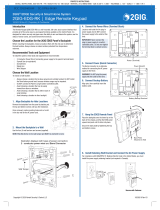 2gig -EDG-RK Edge Remote Keypad Operating instructions
2gig -EDG-RK Edge Remote Keypad Operating instructions
-
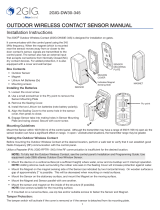 2gig DW30-345 Installation guide
2gig DW30-345 Installation guide
-
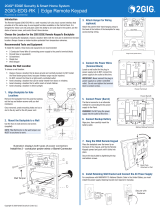 Nortek Control 2GIG Edge Remote Keypad User manual
Nortek Control 2GIG Edge Remote Keypad User manual
-
Honeywell International CFS8DLLMD500 User manual
-
Honeywell International Lyric SIXSIREN User manual
-
ELK ELK-319DWM Operating instructions





















